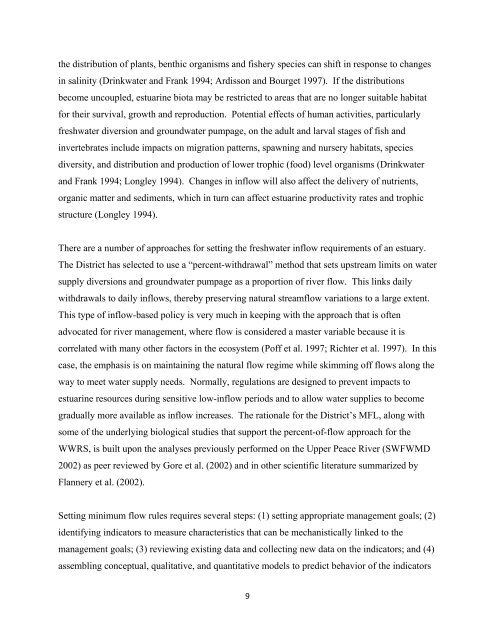Weeki Wachee River System Recommended Minimum Flows and ...
Weeki Wachee River System Recommended Minimum Flows and ...
Weeki Wachee River System Recommended Minimum Flows and ...
You also want an ePaper? Increase the reach of your titles
YUMPU automatically turns print PDFs into web optimized ePapers that Google loves.
the distribution of plants, benthic organisms <strong>and</strong> fishery species can shift in response to changes<br />
in salinity (Drinkwater <strong>and</strong> Frank 1994; Ardisson <strong>and</strong> Bourget 1997). If the distributions<br />
become uncoupled, estuarine biota may be restricted to areas that are no longer suitable habitat<br />
for their survival, growth <strong>and</strong> reproduction. Potential effects of human activities, particularly<br />
freshwater diversion <strong>and</strong> groundwater pumpage, on the adult <strong>and</strong> larval stages of fish <strong>and</strong><br />
invertebrates include impacts on migration patterns, spawning <strong>and</strong> nursery habitats, species<br />
diversity, <strong>and</strong> distribution <strong>and</strong> production of lower trophic (food) level organisms (Drinkwater<br />
<strong>and</strong> Frank 1994; Longley 1994). Changes in inflow will also affect the delivery of nutrients,<br />
organic matter <strong>and</strong> sediments, which in turn can affect estuarine productivity rates <strong>and</strong> trophic<br />
structure (Longley 1994).<br />
There are a number of approaches for setting the freshwater inflow requirements of an estuary.<br />
The District has selected to use a “percent-withdrawal” method that sets upstream limits on water<br />
supply diversions <strong>and</strong> groundwater pumpage as a proportion of river flow. This links daily<br />
withdrawals to daily inflows, thereby preserving natural streamflow variations to a large extent.<br />
This type of inflow-based policy is very much in keeping with the approach that is often<br />
advocated for river management, where flow is considered a master variable because it is<br />
correlated with many other factors in the ecosystem (Poff et al. 1997; Richter et al. 1997). In this<br />
case, the emphasis is on maintaining the natural flow regime while skimming off flows along the<br />
way to meet water supply needs. Normally, regulations are designed to prevent impacts to<br />
estuarine resources during sensitive low-inflow periods <strong>and</strong> to allow water supplies to become<br />
gradually more available as inflow increases. The rationale for the District’s MFL, along with<br />
some of the underlying biological studies that support the percent-of-flow approach for the<br />
WWRS, is built upon the analyses previously performed on the Upper Peace <strong>River</strong> (SWFWMD<br />
2002) as peer reviewed by Gore et al. (2002) <strong>and</strong> in other scientific literature summarized by<br />
Flannery et al. (2002).<br />
Setting minimum flow rules requires several steps: (1) setting appropriate management goals; (2)<br />
identifying indicators to measure characteristics that can be mechanistically linked to the<br />
management goals; (3) reviewing existing data <strong>and</strong> collecting new data on the indicators; <strong>and</strong> (4)<br />
assembling conceptual, qualitative, <strong>and</strong> quantitative models to predict behavior of the indicators<br />
9
















